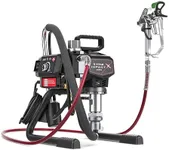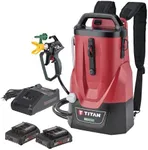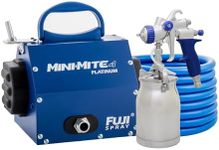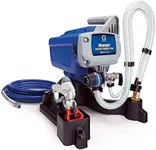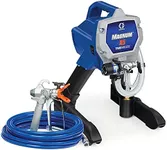Buying Guide for the Best Latex Paint Sprayer
Choosing the right latex paint sprayer can make your painting projects much easier and more efficient. The right sprayer will help you achieve a smooth, even finish and save you time compared to traditional painting methods. When selecting a latex paint sprayer, it's important to consider several key specifications to ensure you pick the best fit for your needs. Here are the main specs to look at and how to navigate them.Type of SprayerThere are three main types of paint sprayers: airless, HVLP (High Volume Low Pressure), and compressed air sprayers. Airless sprayers are great for large surfaces and provide a smooth finish quickly. HVLP sprayers are ideal for detailed work and fine finishes, as they produce less overspray. Compressed air sprayers are less common but can be useful for small projects. Choose the type based on the size and detail of your project.
Spray Tip SizeThe spray tip size determines the width and thickness of the paint stream. Smaller tips (0.009-0.013 inches) are suitable for thin materials like stains and lacquers, while larger tips (0.015-0.019 inches) are better for latex paints. For heavy coatings, you might need even larger tips. Select a tip size that matches the type of paint you will be using and the surface you are painting.
Flow RateFlow rate, measured in gallons per minute (GPM), indicates how much paint the sprayer can apply in a given time. Higher flow rates are suitable for large projects and can help you complete the job faster. Lower flow rates are better for detailed work and smaller projects. Consider the size of your project and how quickly you want to complete it when choosing the flow rate.
Power SourcePaint sprayers can be powered by electricity, batteries, or gas. Electric sprayers are convenient for indoor use and continuous operation. Battery-powered sprayers offer portability and are great for outdoor projects without easy access to power outlets. Gas-powered sprayers are powerful and suitable for large, outdoor projects. Choose a power source based on where you will be using the sprayer and the availability of power.
Hose LengthThe hose length determines how far you can move around without having to move the sprayer unit. Longer hoses (25-50 feet) are useful for large areas and high places, while shorter hoses (10-20 feet) are easier to manage for small projects. Consider the size of the area you will be painting and how much mobility you need when selecting the hose length.
Ease of CleaningCleaning a paint sprayer can be time-consuming, so it's important to choose one that is easy to clean. Look for features like removable parts, easy access to the paint path, and compatibility with cleaning solutions. A sprayer that is easy to clean will save you time and ensure the longevity of the equipment. Consider how often you will use the sprayer and how much time you are willing to spend on maintenance.


